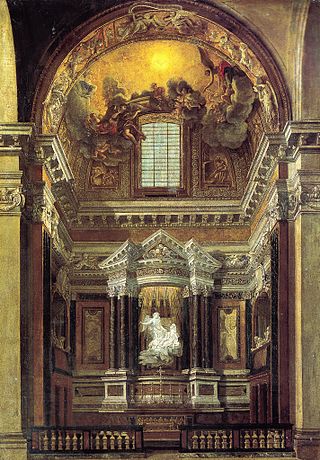Related Research Articles

Ortolano was an Italian painter of the Ferrara School, active in the Renaissance period. Ticozzi cites his birth as ca. 1480.
Jacopo Bambini was an Italian painter of the Baroque period, active mainly in Ferrara.

Simone Barabino was an Italian painter of the late-Mannerist style. Born in Val de Polcevera, near Genoa, he was mainly active in his native city, where he trained with Bernardo Castello. He later feuded with his master and left for Milan, where after some works, he stopped painting. Notable works include San Diego restoring sight to blind child for the Nunziata del Guastato in Genoa and Dead Christ with the Virgin and Saints Michael and Andrew for the church of San Girolamo at Milan. He died in penury. Lanzi says he quit his profession and turned to merchandise, in which he did not succeed, and that be died in prison. The exact date of his death is not known, but he may have been quite old when he died.
Giovanni Antonio Amato or Amati was an Italian painter of the Renaissance period. Born in Naples, he copied the style of Pietro Perugino.
Giovanni Francesco Cassana (1611–1691) was an Italian painter of the Baroque period, active mainly in Genoa.
Giuseppe Appiani was an Italian painter of the Neoclassic periods. He was born in Vaprio d'Adda, near Milan, where he was mainly active. His parents moved to Monza, where his first mentor was the painter Giovanni Maria Gariboldi. At age 21, he moved to Milan, where he worked in the studios of Giorgi, and later Giuliano Traballesi. He was active in restoration of paintings. Another painter, Giuseppe Appiani, was active in Germany.

Domenico Auria was an Italian architect and sculptor of the Renaissance period, active in Naples. He was a pupil of Marliano da Nola. He is also known as Giovanni Domenico or Giovan Domenico Auria, or Domenico d'Auria.

Giovanni Maria Cerva was a 17th-century Italian painter of the Baroque period, active in quadratura in the city of Bologna. Also named il Bagnolino. He was a pupil of Menichino. He was active in 1640.
Bartolomeo Bassi was an Italian painter active in the early-Baroque period, mainly in his hometown of Genoa. He was a disciple of Giovanni Andrea Ansaldo, and painted quadratura. Died at the age of 40.
Giuseppe Bastiani was an Italian painter active in the Renaissance period, mainly in his hometown of Macerata. He was a disciple of Gaspare Gasparini. He painted frescoes in the church of Santa Maria Assunta, Arrone.
Giulio Cesare Begni was an Italian painter active in the early-Baroque period, born in Pesaro, but also active in Fano, Cagli, Venice and Udine. He was a pupil of Antonio Cimatori (Visacci) in Urbino. His works included San Liborio at the Cagli Cathedral, Martyr of a Saint which is now at the Musée des Beaux-Arts, Rennes and frescoes of the Scenes of the Life of St Augustine at the cloister of an Augustinian monastery in Fano. Some sources say that he was active between 1620 and 1680.

Marco Bello was an Italian painter active in the Renaissance period. He was one of the pupils in the studio of Giovanni Bellini.
Antonio Beltrami (1724–1784) was an Italian painter active in the late-Baroque and Neoclassic periods. He was born in Cremona. He was a pupil of Francesco Boccaccino, who emerged from the school of Carlo Maratta. His older brother, Giovanni Battista was an engraver.
Lorenzo Bergonzoni was an Italian painter of the Baroque period. He was born and active in Bologna. He was first a pupil of Giovanni Battista Bolognini, but afterwards studied under Guercino in Cento. He is also called Lorenzo Bergunzi. He became known mostly as a portrait painter at Bologna.

Giuseppe Bottani was an Italian painter active in the Baroque period.
Serafino Brizzi (1684–1737) was an Italian engraver of the Baroque period, active in Bologna. He is believed to have trained with Ferdinando Galli-Bibiena. He was also called Briccio or Brizio.

Simone Brentana was an Italian painter of the Baroque period, active in Verona. He was born in Venice to Domenico Brentana, but became orphaned by age nine. After a prolonged desultory education in various fields including music, he trained as a painter in Venice with Pietro Negri, frequenting the Accademia di Belle Arti, moving in 1685 to Verona, where most of his paintings are located.

Guido Ubaldo Abbatini (1600–1656) was an Italian painter of the Baroque period, active mainly in Rome and Usigni.
Fabio Berardi (1728–1788) was an Italian engraver of the Baroque period, active in Tuscany. He was born in Siena. He went to Venice when young, and trained under Joseph Wagner. Among other works, he engraved in 1767 a booklet of pictures about the life of emperor Francis I. He also engraved the following:
Jacopo de Antonio; also called Jacobello Antonello, Jacobello da Messina, or Iacobello di Antonello, was an Italian painter from Messina, Sicily, active during the Renaissance. He was the son of Antonello Da Messina. Jacobello may be the same as Pino da Messina.
References
- Ticozzi, Stefano (1830). Dizionario degli architetti, scultori, pittori, intagliatori in rame ed in pietra, coniatori di medaglie, musaicisti, niellatori, intarsiatori d’ogni etá e d’ogni nazione' (Volume 1). Milan: Gaetano Schiepatti. p. 291.